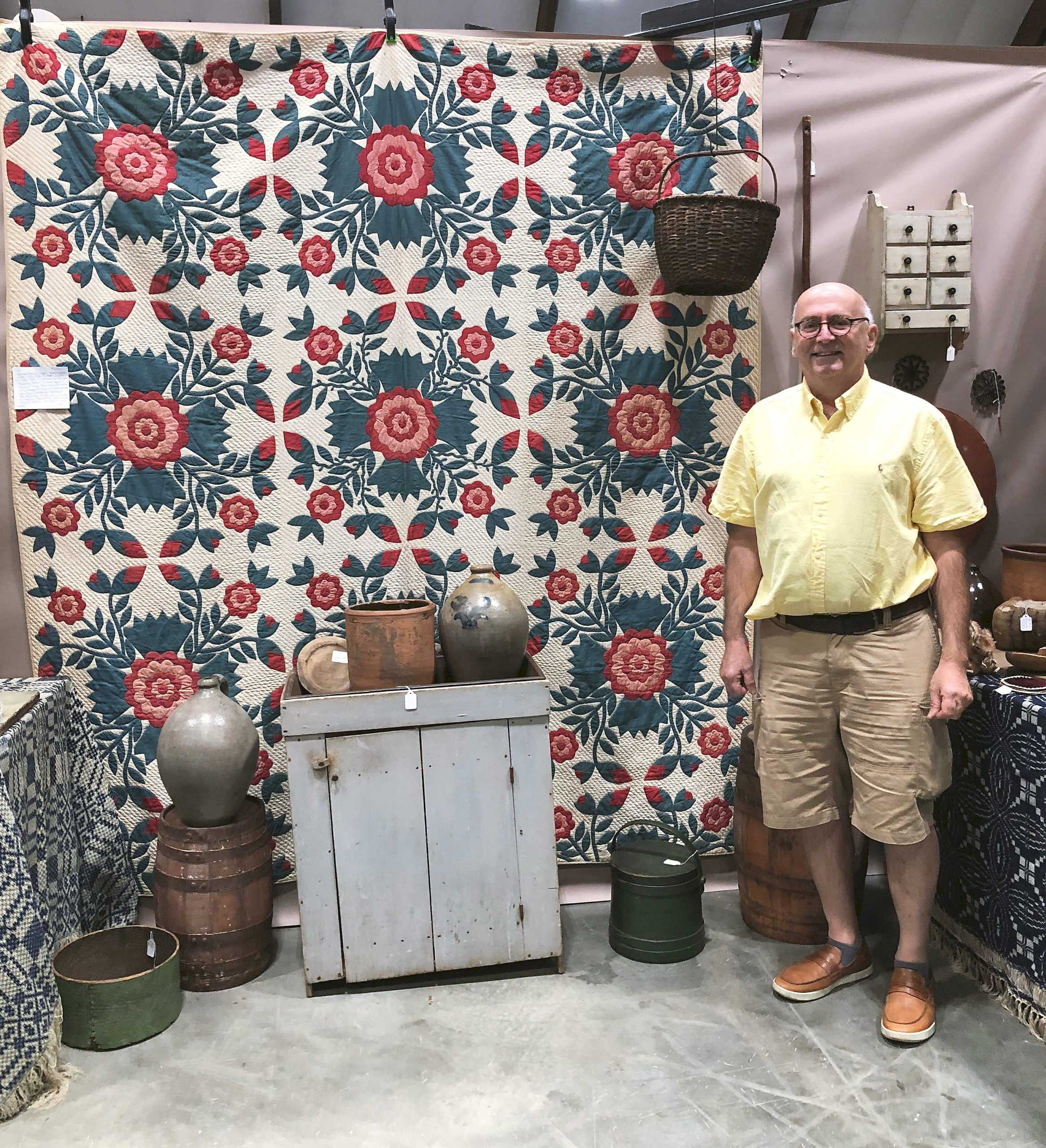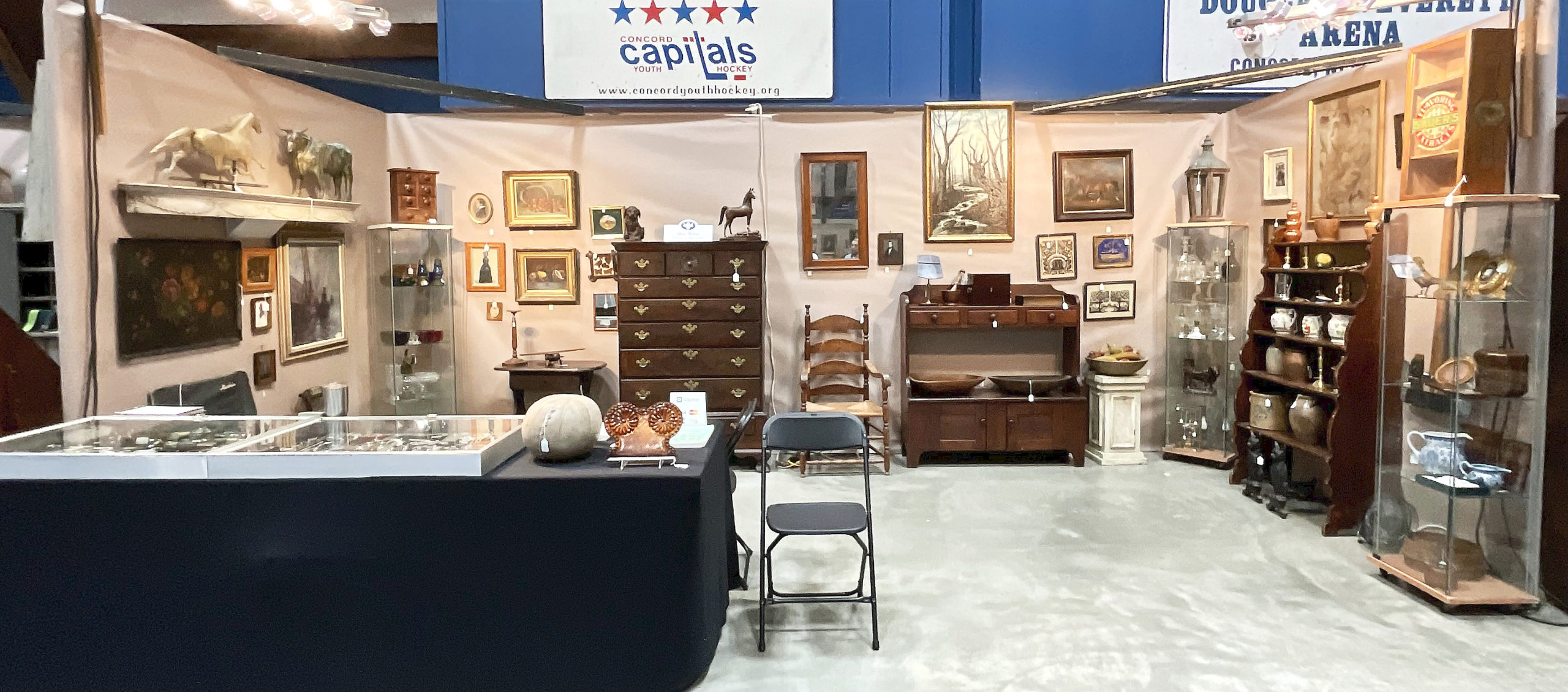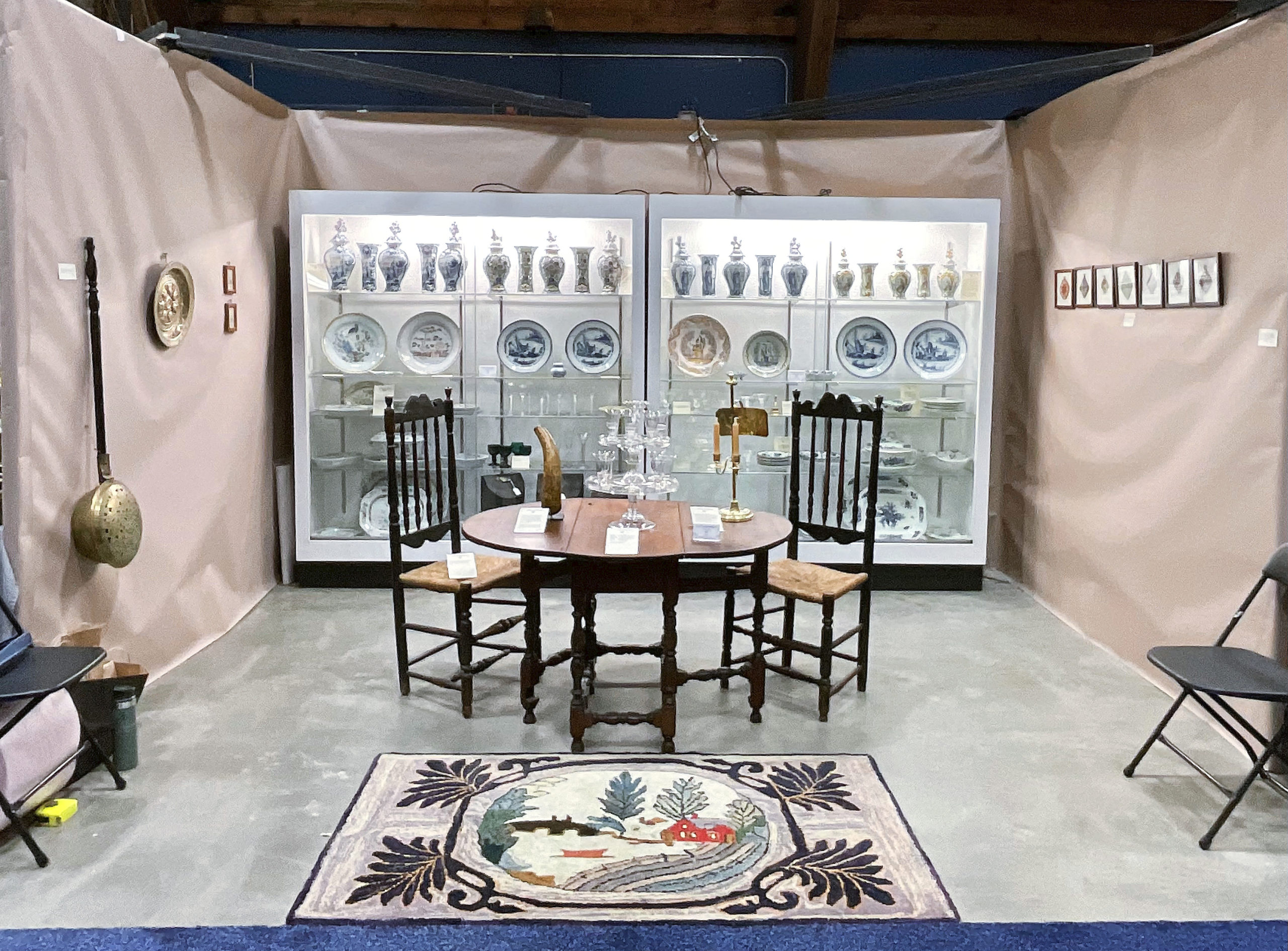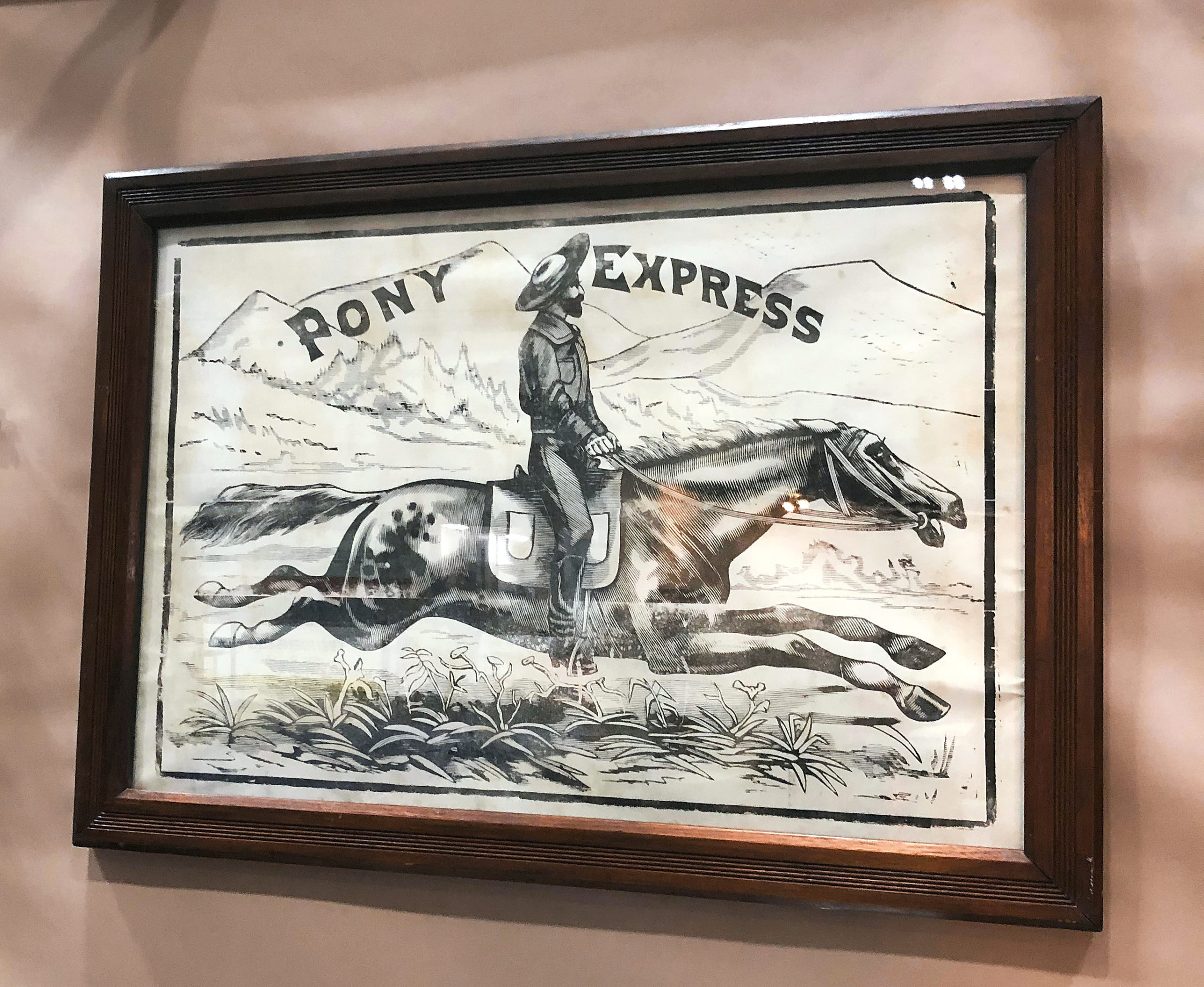
Charlie Guinipero, Pantry Box Antiques, Stafford Springs, Conn., was especially proud of this whig rose pattern quilt for which he was asking $4,500.
Review & Onsite Photos by Rick Russack
CONCORD, N.H. — On August 8, early buyers lined up for the 8 am opening of Peter Mavris’ Americana Celebration in Concord, the third show of New Hampshire’s Antiques Week. When they entered, they might have thought the show was slightly smaller, but Mavris took advantage of the available space to create a floor plan with wider aisles for comfortable browsing. There were about 50 dealers in room-setting booths, most of whom have done the show in previous years. Quality was uniformly high, as it is in the shows Mavris runs during the fall and winter at the Best Western Hotel in Hampton, N.H.
There were a number of booths combining early furniture with other quality material. Morgan MacWhinnie, Southampton, N.Y. may have had the earliest piece of American furniture on the show floor. It was a Hadley, Mass., lift top blanket chest dating to about 1690. The chest was all original with a refinished top, and priced at $45,000. MacWhinnie also had a good selection of early toys, including a circa 1920 tin fire engine at $325 and a small tin steamboat flying two pennants, with a life boat hanging, for which he was asking $450. He also filled a large wooden bowl with more than a dozen colorful wooden tops priced $350.
Marc Witus, Gladstone, N.J., offered an eastern Connecticut paint-decorated chest-on-frame dating to 1765-85. It had unusual, dovetailed backboards and original brasses. The chest came from the Lew Scranton collection, and Witus was asking $19,500. He also brought two good weathervanes; one was a full-bodied copper bull priced $5,750 and the other a full-bodied running horse, but the price was not visible.

Marc Witus, Gladstone, N.J. displayed an eastern Connecticut paint decorated chest-on-frame dating to 1765-85 on the back wall of his booth. With only a minor repair, it was priced $19,000. His weathervanes were on a shelf at the upper left. Photo courtesy of Katherine Bovard.
One of the “folkier” booths in the show belonged to Francis Crespo Art and Antiques from Lancaster, Penn. It was completely filled with colorful carved wooden animals and figures, but the most noticeable object, placed at the front of his booth, was a cat made out of aged tobacco leaves that stood about 29 inches tall. Crespo found the cat in Connecticut, where it may have been made since much tobacco was, and is, grown in that state. After the show, Crespo said that there had been a lot of interest in the cat, which was priced at $650, but it did not find a new home. “That’s okay, I just got it and I’m going to live with it for a while.” He continued, “It was a good show for me, I sold several pieces, including a carved stone owl that I got in Alabama, a good painting and my last sale of the day was about 20 minutes before the show closed. Several of the sales were to retail customers who had come in for the five shows. One sale was to a customer from Chicago, so I’d have to say it was a good show for me.”
Mary Kay Felton of Pond Crossers Antiques, Camden, Maine, was doing the show for the first time with a selection of early European Delft, other early ceramics, glassware and a fine English powder horn dating to about 1605. Felton also had a partial Spode dinner service, circa 1805-15 in the Star pattern, priced at $3,250. Included with the set was a repaired Chinese export porcelain serving dish from which Spode had copied the pattern. Parts of the set had been bought from well-known Wilmington, Del., dealer David Stockwell in the 1980s. The powder horn had been carved when James VI of Scotland was crowned James I of England. It had an incised full-length portrait of James with images of elephants, mythical creatures, vines and much more. It had been in the Frank Cowan collection. Felton was asking $22,000. Everything in her booth was well researched, with informative tags. These items had been in her collection for several years, but with the recent death of her husband, Felton decided to downsize.

Mary Kay Felton, Pond Crossers Antiques, Camden, Maine, priced the delicate, graduated three-tier syllabub with numerous pieces of clear stemware, in the front of her booth, $6,500. Photo courtesy of Katherine Bovard.
Bob Markowitz, Groveland, Mass., said he always does well at this show and did so again this year. He sold several exceptional dioramas, including one with a taxidermized squirrel in the center, surrounded by numerous taxidermized birds. A reverse painted glass and chrome horse racing gambling wheel, with its original blue-painted shipping cases, probably from the 1930s, and a trench art vase made of spent bullet casings both sold. Markowitz also reported selling silhouettes and miniature portraits.
Charlie Guinipero, Pantry Box Antiques, Stafford Springs, Conn., has the knack of fitting more things into a booth than any other dealer we know. In addition to his steady stock of Steiff animals and woodenware, this time he brought a truly exceptional applique cotton quilt that dated to about 1840-60. The red and blue, originally green, Whig Rose pattern quilt was 94 by 83 inches, with nine stitches to the inch. It was backed with fabric often used for making vests and inscribed in brown ink, “Mrs David Northrup, Newton.” The price was $4,500. While conversing with Guinipero, he commented on the amount of merchandise he has been selling on Facebook, saying that he’s been pleasantly surprised at the activity on that venue.

Only one other copy of this lithograph is known according to Doug and Audrey Brown, Kezar Falls Curiosity Shop, Parsonsfield, Maine, and it is in the Buffalo Bill Museum in Cody, Wy. This was the first time they had ever shown it and were asking $10,000.
After the show, Peter Mavris was quite pleased. “Many of the dealers told me that they had the best show they’ve ever had here. Almost all said they’d be back next year. We had about 800 paid admissions and that’s about the same as last year. Everything went smoothly this year. And I’ve heard from a few dealers who did the show in the past but couldn’t get here this time, staying that they’ll be back next year. I didn’t hear a single dealer complain about a lack of business.”
For more information, 207-608-3086 or www.petermavrisantiqueshows.com.
.




















